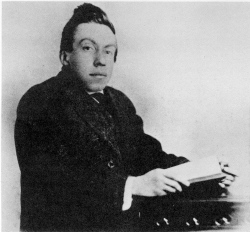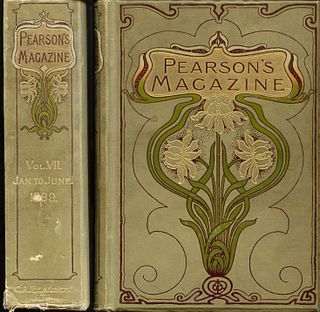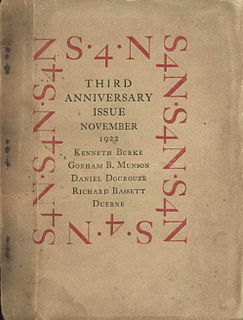Related Research Articles

Randolph Silliman Bourne was a progressive writer and intellectual born in Bloomfield, New Jersey, and a graduate of Columbia University. He is considered to be a spokesman for the young radicals living during World War I. His articles appeared in journals including The Seven Arts and The New Republic. Bourne is best known for his essays, especially his unfinished work "The State," discovered after he died. The essay is the source of the well-known phrase "war is the health of the state," by which Bourne lamented governments' success at arrogating authority and resources during conflicts.

A literary magazine is a periodical devoted to literature in a broad sense. Literary magazines usually publish short stories, poetry, and essays, along with literary criticism, book reviews, biographical profiles of authors, interviews and letters. Literary magazines are often called literary journals, or little magazines, terms intended to contrast them with larger, commercial magazines.

Antiwar.com is a website which describes itself as devoted to "non-interventionism" and as opposing imperialism and war. It is a project of the Randolph Bourne Institute. The website states that it is "fighting the next information war: we are dedicated to the proposition that war hawks and our leaders are not going to be allowed to get away with it unopposed and unchallenged."
A cultural critic is a critic of a given culture, usually as a whole. Cultural criticism has significant overlap with social and cultural theory. While such criticism is simply part of the self-consciousness of the culture, the social positions of the critics and the medium they use vary widely. The conceptual and political grounding of criticism.

Prairie School is a late 19th- and early 20th-century architectural style, most common in the Midwestern United States. The style is usually marked by horizontal lines, flat or hipped roofs with broad overhanging eaves, windows grouped in horizontal bands, integration with the landscape, solid construction, craftsmanship, and discipline in the use of ornament. Horizontal lines were thought to evoke and relate to the wide, flat, treeless expanses of America's native prairie landscape.
The Dial was an American magazine published intermittently from 1840 to 1929. In its first form, from 1840 to 1844, it served as the chief publication of the Transcendentalists. From the 1880s to 1919 it was revived as a political review and literary criticism magazine. From 1920 to 1929 it was an influential outlet for modernist literature in English.

Van Wyck Brooks was an American literary critic, biographer, and historian.
James Oppenheim (1882–1932) was an American poet, novelist, and editor. A lay analyst and early follower of Carl Jung, Oppenheim was also the founder and editor of The Seven Arts, an important early 20th-century literary magazine.

The Harvard Advocate, the art and literary magazine of Harvard College, is the oldest continuously published college art and literary magazine in the United States. The magazine was founded by Charles S. Gage and William G. Peckham in 1866 and, except for a hiatus during the last years of World War II, has published continuously since then. In 1916, The New York Times published a commemoration of the Advocate's fiftieth anniversary. Fifty years after that, Donald Hall wrote in The New York Times Book Review that "In the world of the college – where every generation is born, grows old and dies in four years – it is rare for an institution to survive a decade, much less a century. Yet the Harvard Advocate, the venerable undergraduate literary magazine, celebrated its centennial this month." Its current offices are a two-story wood-frame house at 21 South Street, near Harvard Square and the University campus.
The Little Review, an American literary magazine founded by Margaret Anderson, published literary and art work from 1914 to May 1929. With the help of Jane Heap and Ezra Pound, Anderson created a magazine that featured a wide variety of transatlantic modernists and cultivated many early examples of experimental writing and art. Many contributors were American, British, Irish, and French. In addition to publishing a variety of international literature, The Little Review printed early examples of surrealist artwork and Dadaism. The magazine's most well known work was the serialization of James Joyce's Ulysses.
American modernism, much like the modernism movement in general, is a trend of philosophical thought arising from the widespread changes in culture and society in the age of modernity. American modernism is an artistic and cultural movement in the United States beginning at the turn of the 20th century, with a core period between World War I and World War II. Like its European counterpart, American modernism stemmed from a rejection of Enlightenment thinking, seeking to better represent reality in a new, more industrialized world.

Alfred Francis Kreymborg was an American poet, novelist, playwright, literary editor and anthologist.

The Masses was a graphically innovative magazine of socialist politics published monthly in the United States from 1911 until 1917, when federal prosecutors brought charges against its editors for conspiring to obstruct conscription. It was succeeded by The Liberator and then later The New Masses. It published reportage, fiction, poetry and art by the leading radicals of the time such as Max Eastman, John Reed, Dorothy Day, and Floyd Dell.

The Messenger was an early 20th-century political and literary magazine by and for African-American people in the United States. It was important to the flowering of the Harlem Renaissance and initially promoted a socialist political view. The Messenger was co-founded in New York City by Chandler Owen and A. Philip Randolph in August 1917.

Jane Heap was an American publisher and a significant figure in the development and promotion of literary modernism. Together with Margaret Anderson, her friend and business partner, she edited the celebrated literary magazine The Little Review, which published an extraordinary collection of modern American, English and Irish writers between 1914 and 1929. Heap herself has been called "one of the most neglected contributors to the transmission of modernism between America and Europe during the early twentieth century." Susan Noyes Platt." The Little Review: Early Years and Avant-Garde Ideas,” in Sue Ann Prince, ed, The Old Guard and the Avant-Garde, Modernism in Chicago 1910- 1940, University of Chicago Press, 1990, pp. 139-154 Susan Noyes Platt, “Mysticism in the Machine Age: Jane Heap and The Little Review” Twenty One Art and Culture, Fall 1989

Waldo David Frank (1889-1967) was an American novelist, historian, political activist, and literary critic, who wrote extensively for The New Yorker and The New Republic during the 1920s and 1930s. Frank is best known for his studies of Spanish and Latin American literature and culture and his work is regarded as an intellectual bridge between the two continents.

Pearson's Magazine was a monthly periodical that first appeared in Britain in 1896. A US version began publication in 1899. It specialised in speculative literature, political discussion, often of a socialist bent, and the arts. Its contributors included Upton Sinclair, George Bernard Shaw, Maxim Gorky, George Griffith, H. G. Wells, Rudyard Kipling, Dornford Yates and E. Phillips Oppenheim, many of whose short stories and novelettes first saw publication in Pearson's.
Theophilus Lewis (1891–1974) was an African-American drama critic, a writer, and a magazine editor during the Harlem Renaissance whose contributions primarily appeared in The Messenger, the socialist African-American magazine founded by A. Philip Randolph and Chandler Owen. Lewis was well known for his staunch support of the advancement of a black aesthetic in the arts, particularly the advancement of plays that represented African-Americans well.

S4N is an American "little magazine" that was published from 1919–1925 in Northampton, Massachusetts. In its earliest stages, editor-in-chief Norman Fitts described the magazine as a "discussion of the arts in a monthly magazine". The magazine published contemporary poetry and stories, as well as essays discussing the direction of Modernism in art and music. Among the notable poets, writers and literary theorists that were published in the magazine were E.E. Cummings, Hart Crane, Kenneth Burke, and Malcolm Cowley. In The Little Magazine: A History and Bibliography, Frederick J. Hoffman's authoritative work on little magazines, contends that S4N, along with Broom, Secession, and Seven Arts, were trend-setters and leaders of innovation.
Casey Nelson Blake is a historian and the Mendelson Family Professor of American Studies at Columbia University. He has written Beloved Community: The Cultural Criticism of Randolph Bourne, Van Wyck Brooks, Waldo Frank, and Lewis Mumford (1990) and edited The Arts of Democracy: Art, Public Culture, and the State (2007).
References
- ↑ The Seven Arts. p. 52.Missing or empty
|title=(help) - ↑ The Seven Arts. p. 53.
- ↑ Van Wyck Brooks (1962). Fenollosa and his Circle: With Other Essays in Biography. p. 309.
- ↑ James Oppenheim (1930). "The Story of The Seven Arts". American Mercury. pp. 162–63.
- ↑ http://fair-use.org/seven-arts/1917/06/the-war-and-the-intellectuals
- ↑ http://fair-use.org/seven-arts/1917/07/below-the-battle
- ↑ http://fair-use.org/seven-arts/1917/09/a-war-diary
- ↑ Frederick Hoffman; Charles Allen & Carolyn F. Ulrich (1946). Little Magazine: A History and Bibliography. p. 92.Missing or empty
|title=(help) - ↑ Casey Blake (1990). Beloved Community: The Cultural Criticism of Randolph Bourne, Van Wyck Brooks, Waldo Frank, and Lewis Mumford. p. 123.